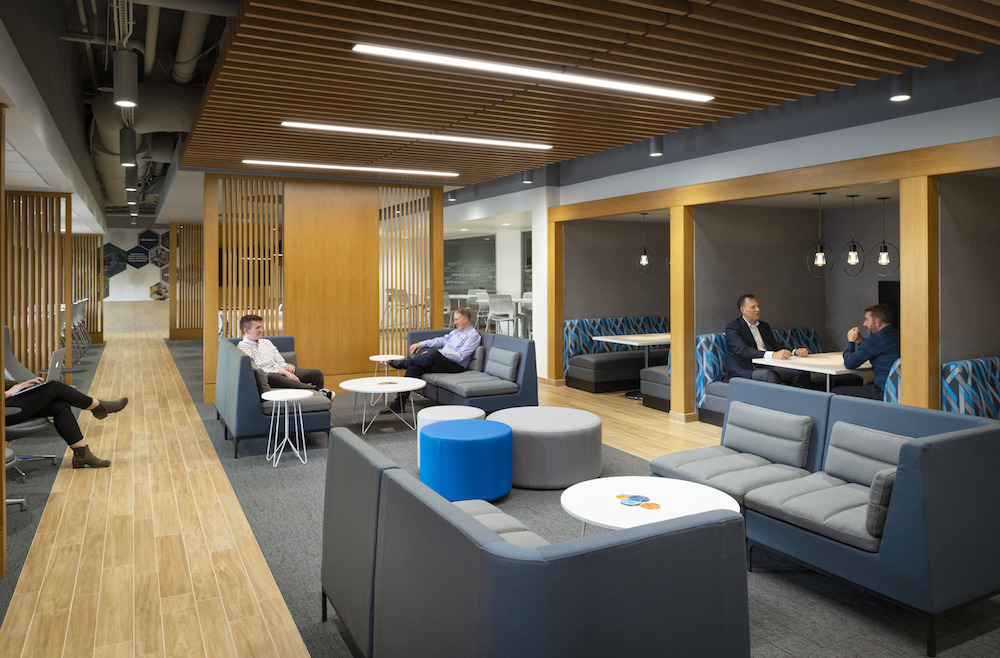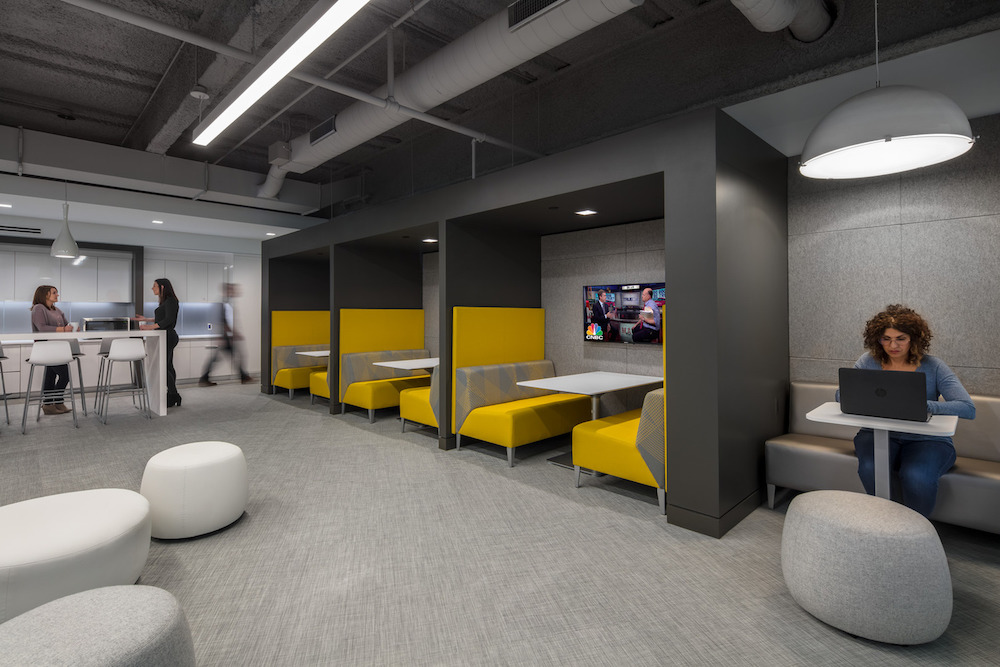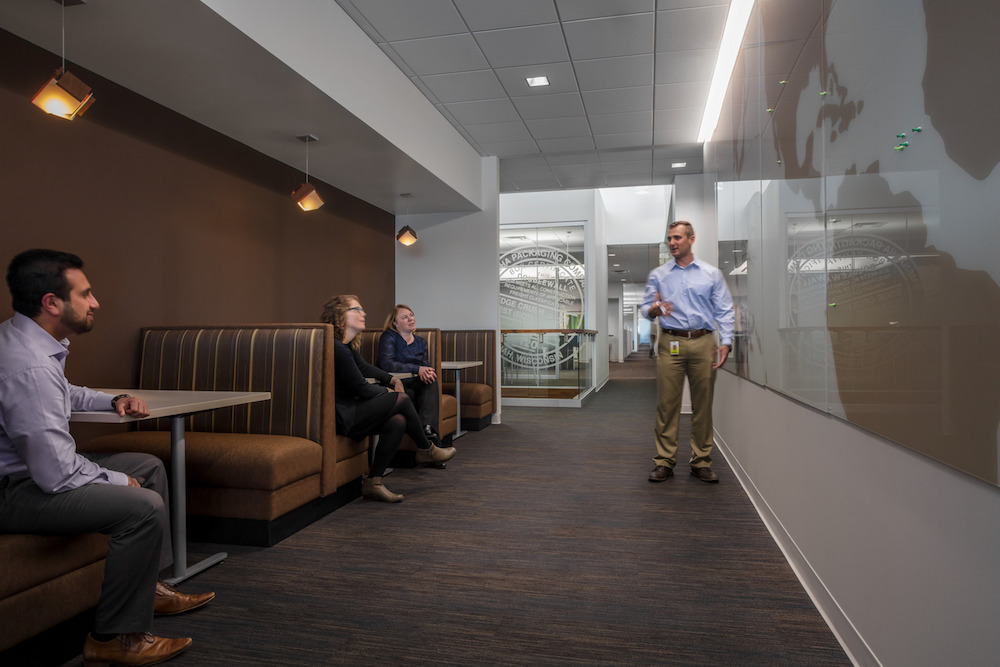For most of us in the corporate workplace, we were launched into a remote work setting overnight in response to the global pandemic spreading throughout the world. As a result of these circumstances, corporations are looking to infuse more flexible work options into their policies, and in turn, looking at the impact on their overall real estate footprint. As clients ask about the future relevance of the physical workplace environment, I ask them to consider: what is the culture of your organization and how do current and future employees connect to that culture? Also, what are the goals and objectives of your organization and how are team and individual work processes best supported in order to achieve those? As we navigate the return to the office and move towards what is inevitably a more flexible work environment, elevating opportunities for trust and empowerment amongst employees and within the culture will be integral in successful future workplace strategies.
Cultures that truly exude trust and empowerment embrace employee choice and control; supporting employees where, when and how they can be most productive. The article the Neuroscience of Trust states, “Employees in high-trust organizations are more productive, have more energy at work, collaborate better with their colleagues, and stay with their employers longer than people working at low-trust companies.” In this scenario, a true harmony between people (culture), place and technology can be achieved.
As we navigate the return to the office and move towards what is inevitably a more flexible work environment, elevating opportunities for trust and empowerment amongst employees and within the culture will be integral in successful future workplace strategies.
As we think about an infusion of varied levels of in-office work, remote work or a combination of the two, cultural alignment will be key. When I consider place and technology’s impact on culture, specifically in regards to empowering and showing employees trust, there are three key elements: variety in surroundings and senses, choice + control to accommodate individual preference of when and where to work, and flexibility that supports short and long-term collaboration goals.
Variety [stimulating the senses]
Trust, employee experience and culture are all correlated, and design plays an integral role in supporting this relationship. When I think of how variety impacts the office setting, I think of elements that touch all our senses.
Several elements within the physical environment have been studied to increase higher levels of productivity, but the one that rises to the top for me is the employee’s desire for access to natural light and views to the outdoors. Researcher findings like this study by Cornell University Professor Dr. Alan Hedge reinforce the connection of natural light and employee well-being, finding that optimization of natural light in an office significantly improves employee health and wellness, with workers reporting reductions in eye strain, headaches and drowsiness. Other studies have also supported this finding with natural light and views to the outdoors being a highly desired attribute of the workplace environment by employees.
The other important feature variety plays in the workplace setting is indicating to people visual cues on the anticipated behaviors of each work setting. With wide open work environments, it may be difficult for employees to understand collaborative versus quiet zones. Subtle visual cues from one space to another, such as unique spatial and lighting treatments to demarcate zones and cue employees to specific use, can improve employee experiences.
Circling back to these senses, it is also important to have environments that are adaptable to individuals’ preferences with a mix of calming and energetic settings that support desired activities, behaviors, sensory and spatial experiences to enhance job satisfaction. So, what are other ways variety can be integrated into the work setting? Material selection stimulates the five senses and promotes positive experiences. Material choices and color palettes not only have the ability to emphasize culture and brand, but provide visual cues to denote heads down or collaborative areas.

In a post-pandemic workplace, variety will also support those chance interactions that lead to trust building within a work environment. In Brene Brown’s book, Dare to Lead, she shares that trust is built in the small moments, not the large events. When we consider how this relates to the future workplace with increased flexibility in working arrangements, a variety of spaces that employees can transition to throughout the workday will further elevate those opportunities for chance interactions and human connections to take place – creating small moments of interaction and trust building.
Choice + Control [to choose how you want to work]
Providing Choice + Control in the workplace offers a form of equity for all – supporting individual preferences and work styles. A lot of factors go into loving where you work. As we start to look ahead at Gen Z’s preferences—soon to be the dominant generation in the workplace—they have expressed interest in choice and control. Although I truly believe that being able to work where you work best, isn’t just a generational preference; it can play a larger role in overall job satisfaction and the desire to stay with a company long term. Choice + Control is also an employee engagement strategy. A Harvard study found that “people who felt trusted at work were 50 percent more productive, took 13 percent fewer sick days, were 76 percent more engaged, and displayed less stress and burnout than those whose companies were considered low-trust.”

Every employee from the top executive to the entry level intern has needs for periods of concentration versus collaboration. By providing people choice of the right setting with the right technology to meet their needs, opportunities for success are harnessed. In Susan Cain’s book Quiet: The Power of Introverts in a World That Can’t Stop Talking, she discusses how the best office is the one that gives people a choice of how much stimulation is coming at them at any one time. The four elements discussed are: permission to be alone, user control over environment, sensory balance and psychological safety, or the choice of being seen or unseen by others.
This speaks to rejecting the one-size-fits all approach of canned floorplates with seas of workstations that basically insinuate that everyone works the same way. Choice + Control recognizes that everyone has their own way of working and empowers people to choose what works best for their given task.

Another option we have been increasingly discussing, that enhances Choice + Control for employees, is free address seating. While it is not a new concept, it’s one that many organizations have not fully embraced in the past. As Brian Pitman shared, it may just have a place in the post-pandemic work world. A free address strategy not only provides ease in optimizing real estate but also in helping people quickly and easily shift their teaming arrangements, exemplifying empowerment and inherent trust of employees.
Flexibility [to change as needed]
Flexibility is the final element to a successful workplace that promotes trust and empowerment—an element that many times also supports an organization’s business goals. It’s a given that every client we talk to wants flexible environments to support the ebb and flow of departments and the churn rates of workforces, while reducing future expenses as office needs shift. But the question of if the space ─ technology, furniture and walls ─ can handle the moving parts within it, is a bigger hurdle to jump. There are real costs to organizational churn (transferring technology, moving costs, etc.), averaging $150-$275 per employee, according to FM Link’s survey of over 80 Fortune 1000 companies. Mergers, acquisitions, partnerships, outsourcing and major strategic initiatives can impact employee and team configurations. Having a strategy that addresses flexibility around these events is key to empowering teams and individuals to reconfigure and react quickly to meet changing business needs.
But beyond the basic business need, flexibility comes down to if teams are empowered to feel like they can flex or be agile; picking their work settings and retooling their space through measures like shifting white boards or reorganizing furniture can help create innovative settings to support teams. One way this can be done is by giving departments input and autonomy during the design process on how their space is utilized to support their work.

Looking at the return to workplace post-pandemic, I see flexibility continuing to play a large role in how the office supports culture. I think we’ll see traditional work cafés leveraged as working environments to support social distancing efforts, as well as solutions that put workstations on casters to allow for quick shifts within any given day.
Trust + Empowerment [a lasting value proposition]
I fully recognize that global entities are already successfully doing collaborative and innovative virtual work across the world every day, even during our current pandemic. But what I have experienced is that the virtual encounters are lacking compared to in-person qualities and connections, specifically in building trust within an organization. I believe trust and empowerment is the key to creating a lasting value proposition, and in turn employee retention. Everyone is looking at some way to provide Choice + Control in how people work, and I anticipate the number of dispersed workforces with a mix of home and office settings will grow, but what will be the right solution for your organization? Are you considering your culture, in the space considerations for the future?
